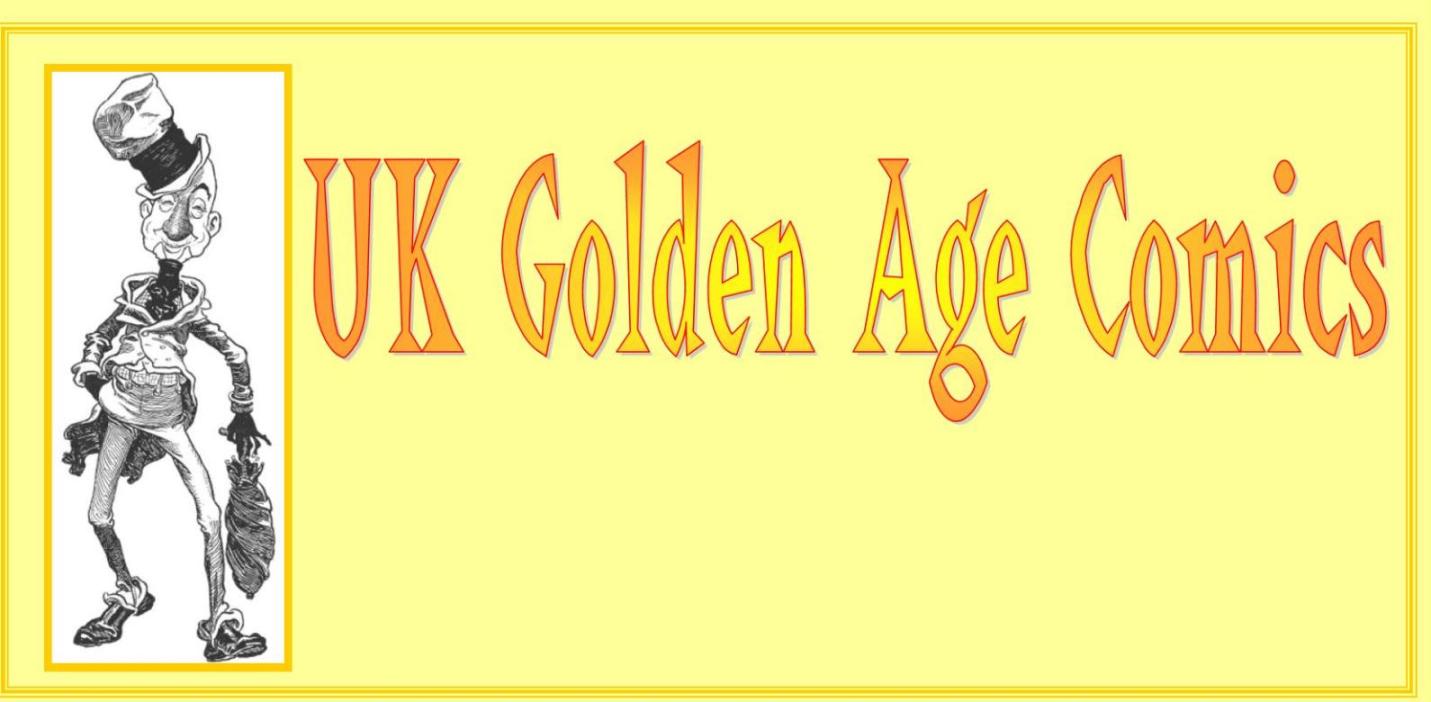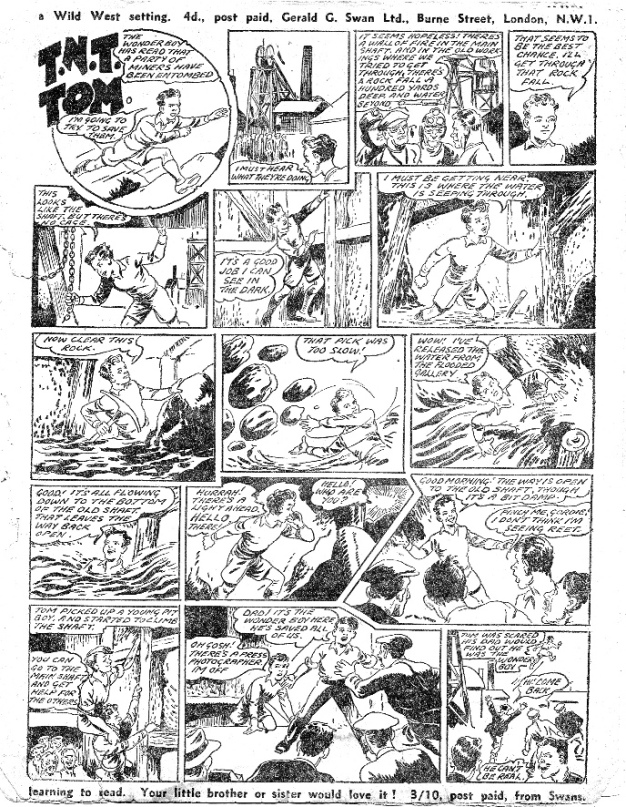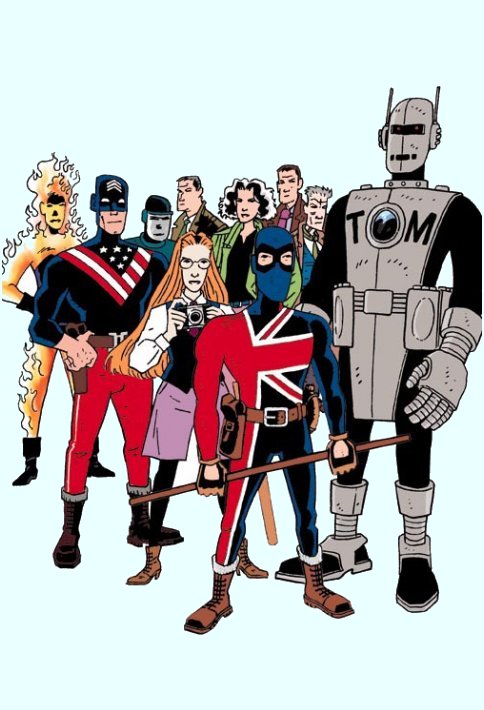The question has allways been, for me, do I 'reboot' UK Golden Age comic characters or do I leave them as they were?
Let's
be honest here: there was no big writer-artist teams in UK comics of
the 1939-1951 period. No Simon and Kirby's. We've never really had an
idea of what creators were paid in those days but I'm going to guess it
was not a great deal. Comics were cheap, throw-away entertainment that
only cost a few pennies.
Gerald Swan is the best known
publisher from this period and his attitude seemed to be that there was a
huge gap in the market left by import restrictions (thanks to that
Hitler bloke). Swan was an entrepreneur and he paid what he thought was
appropriate. No doubt Harry Banger and others who could supply strips
on a weekly basis got the best deals but even then the creator had to
keep churning out the work.
I doubt that one of these
men -or women- sat down one day and plotted a long term storyline for
their characters. This was not the "Marvel Age of Comics" and with all
the restrictions facing publishers I doubt whether many even believed
more work would be coming in and even if it was -for how long?
So, it was basically a strip with a few vizual gags and then a punchline
or "wham bam action!" in the space of one or a few pages. No great
characterizations.

Take
Zom of the Zodiac
by S. K. Perkins. One story in which Zom peeks around a corner, turns a
bullied man into a taller, better looking man to trouncew the bully but
when said man becomes too full of himself...Zom changes him back. Yes,
probably a moral in there and we Brits loved some morals in our comic
strips! But you have to ask -"What?" "Who?" "Why?"

I've
used Zom now for almost 30 years and developed him into a more complex
character but those questions still apply to a degree. He seems to be
friends with The All Seeing Eye, has had a hand in guiding super
heroes/crime-fighters over the decades if not centuries but we still
have no 100% answer to who or what he is. The Green Skies will see a
little more revealed and, perhaps, a glimpse or hint at who he might be.
And
TNT Tom, and later his cousin Tina: given powers by aliens, Tom saves
miners after a cave-in, stops a gang of cop-killers and even saves Earth
from biological attack by aliens. His main concern? That his dad does
not find out "the Wonder Boy" is none other than his own son. Luckily,
the odd press photographer is avoided but imagine TNT Tom based in 2013
with all the cameras, cell phones, dvrs and so on!
Characters
such as Moon Man or Marsman had one off appearances but over the years
they have been developed somewhat. In the Black Tower universe there
is
life on Mars, albeit underground -even an explanation as to why the
various Martian races took that root. For the Moon Man, well, we have a
very rich literary history of Selenite civilisation from the pulps
onward. Both Mars and the Moon races feature in Green Skies (the
Martians referring to Earth people as "our biological cousins" which
ties in with the belief that life on Earth may have originated from
Martian meteorites).
Rodney Dearth, creator of The Iron
Warrior has been a bit of a regular in Black Tower over the years -can
anyone forget 2011s incredible
The Iron Warrior Vs Big Bong??
Dearth was, as I've pointed out in previous postings, a typical
Colonial Britisher. Save you going all the way back to 2011 postings...
Was The Iron Warrior A Villain???
It occurs to me that,today,a lot of comickers who have no real
knowledge of UK Golden Age characters will make things up or make bad
guesses based on what they might have seen.
This can be said to be true when it comes to the
Iron Warrior.
I can onloy find one source with any information on the character up to 1990 and that is the late Denis Gifford’s
Encyclopedia of Comic Characters [Longman,London,1987]. In the entry for The Iron Warrior,Gifford writes:
“
..the most violent and bloodiest strip ever seen in British comics
to this time,and for several decades to come. Rodney Dearth,seeking
the Jewels of Junius,arrives at the site of the Temple of Sloth in
Central Africa,accompanied by his robot,the Iron Warrior. Captured by a
White Princess,he summons the Warrior (‘wavelength 60,impulse 400′).
Crying ‘I come Master!’ and also ‘Ahrrr! Whoo-roo! Roar!’,the
Warrior’s built-in chopper slices up the Sloths,cuts up a giant
crocodile,and pulls the head off an outsize eagle.”
And from this we get entries in the Internationalheroes site:
“A robot controlled by Rodney Dearth, who used it to hunt treasure with him in Africa.
The Warrior isn’t really a hero, as it kills anyone who threatens its master, whose own goals are far from altruistic.”
Hmm. But then we get,at the League for Extraordinary Gentlemen fan site:
“The Surrogate League of Extraordinary Gentlemen
When the government decided to form the Worral’s League they based it very closely on Mina’s first League, “
When
in 1946 it was apparent that Miss Murray and her colleagues had
deserted our employ by going missing in America, MI5 elected to replace
the group with surrogates in an attempt to recreate the impact of the
1898 ensemble…”
- The Invisible Man (Peter Brady) = The Invisible Man (Hawley Griffin)
- Prof James Gray = Nemo (both submarine builders, Nemo even inspired Gray in League V2)
- Worrals = Mina (female leads experienced in death)
- Wolf of Kabul = Quatermain (both in the great white hunter tradition, they even both wear pith helmets)
- The Iron Warrior = Hyde (both really killers pressed into service).
The Iron Warrior is a robot built by Rodney Dearth, Dearth was not a
hero and had a more villainous overtone. He would command the Warrior
to do various illegal things, including kill people, but mainly Dearth
used him to hunt for treasure in Africa.”
 YAAAR! RRRAHHH! NOOOOOOOOOOOOOOOOOOOOOOO!
YAAAR! RRRAHHH! NOOOOOOOOOOOOOOOOOOOOOOO!
Oh. I do beg your pardon. Had a bit of an “Iron Warrior” moment
there. Seriously,I hate this whole “we know nothing about the character
but it seems it was a killer controlled by a killer so let’s write
that” crap.
“…Dearth was not a hero and had a more villainous overtone. He would
command the Warrior to do various illegal things, including kill
people.”
Dearth was
not a villain or scheming killer.
Anyone read any old boys adventure books or H. Ryder Haggard? By
applying what the League page and Internationalheroes entry has written
then we have to re-classify Alan Quartermaine as a cold blooded
villain. In fact,up until more politically correct times,most heroes
would need to be re-classed according to this methodology. Biggles
takes on arch villain proportions. Even Indiana Jones would be classed
as out-doing the Nazis considering how many deaths he’s caused directly
or indirectly. Think on that.

Let’s get a little bit of perspective here. Sit down kiddies because
if you’ve not watched any films made between 1920 to…well…now,and if
you’ve not read any history on the British Empire or American
Imperialism ["Hey,Japan:we've gun ships and troops harbored offshore now
do business with us 'voluntarily' or we'll make you!"] -in fact any
empire or power!- you may be shocked.
Most sea-faring nations such as Spain,Italy,England,France etc.,sent
out exploratory ships/fleets to seek out new lands and new treasures and
subdue the local population by any means including genocide [keep some
alive for slaves,of course]. The Ashante were great at being slavers
and made a lot of money out of it. It’s a two-way thing you see -are
black african slavers villains? Hey,slavery still exists today and
amongst some of the West’s best pal nations.
But these Europeans were brave hero-explorers. Anyone hear of a little
group called the Conquistadores? Dutch East India Company? The
British East India Company -all had their private armies to,uh,”smooth
things through”.
Ever read
King Solomon’s Mines?
In comparison,Dearth was a limp-wristed liberal! Hmm. If you were a
British soldier at Rourke’s Drift with Zulu warriors rushing toward you
would you throw down your rifle and wave -”Hello! I’m really against
all this imperialism stuff -care for tea and a chat?” Mind you,in
Zulu Dawn,Denholm Elliott’s character more or less did just that -and was killed straight away!
Whichever city you lived in -London,Berlin,Paris- you would hear
stories of strange lands,lost treasures and much more. The urge to
follow those tales continue to this very day. If a chap was on his
uppers and the old estate was falling to bits and,to be frank,the family
coffers had been emptied long ago it was disgrace and destitution -but
if you could find the “lost treasure” or anything worth a few quid you
were saved!
I
know that it is wrong to just go marching
in,putting down the “locals” and stealing things that belong to
them,whether they want to exploit it themselves or not –hey,I’m still
for returning the Elgin Marbles and all those Egyptian artefacts
we,uh,borrowed!
The context is that this was a totally different world. Officers and
troopers posing for photographs of themselves resting their feet on a
heap of natives heads should have been totally unacceptable even in the
19th century but it happened -apparently “fun” hunts were organised
with horse-riding officers carrying “pig-stickers” but I get a feeling
the natives involved weren’t having too much fun!
A white man would have his weapons because,even if a peaceful
person,not all native persons were friendly in return [read some
history]. I could write on the subject all day but it wouldn’t help.
The point is that we know,in the Iron Warrior strip,only that Dearth
arrives in Africa with his creation. If attacked he defended himself.
In volume 3 of the Black Tower Gold Collection,I published such a
strip. Dearth is exploring an area when a local priest stirs things up
-Dearth is attacked and,though he could easily do so,he does not set
about killing everyone. In fact,he does fend off an attack by rushing
straight at the warriors but then tries to use cunning to defeat the
witch doctor.
Once the threat is sorted,Dearth goes on his way. The one thing we see
is that the Iron Warrior is far from some type of remote-controlled
killer doing its master’s bidding. It’s what would today be called a
controlled vehicle or “power suit”.
Dearth get’s inside the Iron Warrior and operates controls and fires
his weapons from here. He also operates the axe-wielding arm. Guessing
at Dearth’s height the Iron Warrior has to be around 3-4 metres tall
[10-12 feet]. But,it is still nothing more than a kind of hostile
environment suit -almost similar to later [better designed] deep water
suits.
What Denis Gifford wrote I have to take to be accurate -he did have a massive collection. So,I’m
guessing that
there was a remote control device and,it seems,a vocaliser of sorts.
This does not appear in the later strips I’ve seen. That
said,continuity was never a great strongpoint in comics back then.
Yes,the strip was violent but you have to recall that in early Tarzan
films there were people being killed violently and arrows sticking out
of heads. And,sadly,in war time Britain death was a daily event and kids
[and adults] enjoyed a good “Darkest Africa” story with some white
chap up against the natives.
So,do not think that,based on what people who have a narrow view of a
character write,that Dearth and the Iron Warrior were just deadly
killers. They weren’t.
Now,back to Big Bong!
 The Iron Warrior vs Big Bong:When Giants Fought
The Iron Warrior vs Big Bong:When Giants Fought,written & drawn by Ben R.Dilworth is available from:
http://www.lulu.com/hoopercomicsuk
The
thing is that you have to understand the age these characters come
from. Putting 21st century sensibilities or any modern day ideas into
characters from the mid-20th century just make them horrible Marvel or
DC style reboots
How does this work when the characters
come into contact with contemporary Black Tower characters? Well, buy
the books and find out! Following Green Skies there will be a more
formalised chronology for the characters so that there is a definite
JLA-Justice Society (Earth 1 and Earth 2) vibe going on. Though the
characters have met before the Green Skies saga will clear things up for
newer readers but -and I have to emphasise this- the characters are not
changed and certain not rebooted!!
If you cannot treat
characters with certain respect and try to stay true to how they first
appeared then you have failed as a creator. We do not have to reboot so
that TNT Tom is afraid his father will find out he is the Wonder Boy
because his father is a violent child beater!!
The
reaction from people who first read the comics as kids 60-70 years ago
and purchased the Black Tower reprints was that they were "over joyed"
and thought they would never see their favourite characters again.
Okay, not great sales but just those few comments give me a big boost.
You
can add or develop these old characters but you MUST be true to what
they were and, being honest, the industry is swamped in reboots,
darkness, blurry-lined "good and evil" and just not enough fun.
Yes, I'm an old fart but I think you still have to see comics as having some fun...
































